centos下nginx搭建drupal 8
环境:centos 7.6,nginx 1.5.18,php 7.3,drupal 8.8.5
drupal 8版本系统要求:
php 7.2以上
数据库要求:MySQL 5.5.3/MariaDB 5.5.20/Percona Server 5.5.8 以上版本并且使用InnoDB数据库引擎, 和 PDO 数据库扩展.
web服务器:apache、nginx、IIS等支持php的服务都可以。
一、nginx
1.nginx安装和配置
# yum install -y https://dl.fedoraproject.org/pub/epel/epel-release-latest-7.noarch.rpm //安装最新版epel软件源
# yum install -y yum-utils //安装yum工具
# yum install -y nginx
# setenforce 0 //设置selinux模式,最好再修改配置文件/etc/selinux/config,把enforcing改为permissive
# firewall-cmd --add-service=http --permanent //开放http服务
# firewall-cmd --reload //更新防火墙策略
启动nginx:
# systemctl enable nginx
# systemctl start nginx
2.验证nginx
浏览器访问服务器地址
二、php
1.php7.3安装
由于centos软件仓库的php版本太低,所以需要第三方仓库安装高版本的php,这里使用remirepo.net提供的仓库。
# yum install -y https://mirrors.tuna.tsinghua.edu.cn/remi/enterprise/remi-release-7.rpm //使用清华大学的镜像源安装
由于remi网站是外国站点,访问不稳定,建议更改仓库的地址使用清华镜像。
修改/etc/yum.repos.d/remi-safe.repo和remi-php73.repo,将mirrorlist的行注释掉。
接下来,取消注释文件里baseurl开头的行,并将其中的http://rpms.remirepo.net替换成https://mirrors.tuna.tsinghua.edu.cn/remi
也可以用如下命令自动替换:
# sed -e 's!^mirrorlist=!#mirrorlist=!g' \ -e 's!^#baseurl=!baseurl=!g' \ -e 's!http://rpms\.remirepo\.net!https://mirrors.tuna.tsinghua.edu.cn/remi!g' \ -i /etc/yum.repos.d/remi-safe.repo /etc/yum.repos.d/remi-php73.repo
启用php 7.3版本的remi源
# yum-config-manager --enable remi-php73
安装php 7.3和相关扩展
# yum install php php-pdo php-opcache php-mbstring php-fpm php-gd php-xml php-pdo php-pecl-mcrypt php-mysqlnd
修改fpm的配置文件/etc/php-fpm.d/www.conf
;listen = 127.0.0.1:9000 //注释掉该行 listen = /var/run/php-fpm/php-fpm.sock //设置socket ;listen.owner = nobody //原设置默认就是注释掉的 ;listen.group = nobody //原设置默认就是注释掉的 ;listen.mode = 0660 //原设置默认就是注释掉的 listen.owner = nginx //增加该行 listen.group = nginx //增加该行
启动php-fpm
# systemctl enable php-fpm
# systemctl start php-fpm
配置nginx,修改/etc/nginx/nginx.conf文件:
user nginx; worker_processes auto; error_log /var/log/nginx/error.log; pid /run/nginx.pid; include /usr/share/nginx/modules/*.conf; events { worker_connections 1024; } http { access_log /var/log/nginx/access.log; sendfile on; tcp_nopush on; tcp_nodelay on; keepalive_timeout 65; types_hash_max_size 2048; include /etc/nginx/mime.types; default_type application/octet-stream; include /etc/nginx/conf.d/*.conf; server { listen 80; root /var/www/html; location / { try_files $uri /index.php; } location ~ '\.php$|^/update.php' { fastcgi_split_path_info ^(.+?\.php)(|/.*)$; # Ensure the php file exists. Mitigates CVE-2019-11043 try_files $fastcgi_script_name =404; include fastcgi_params; # Block httpoxy attacks. See https://httpoxy.org/. fastcgi_param HTTP_PROXY ""; fastcgi_param SCRIPT_FILENAME $document_root$fastcgi_script_name; fastcgi_param PATH_INFO $fastcgi_path_info; fastcgi_param QUERY_STRING $query_string; fastcgi_intercept_errors on; # PHP 7 socket location. fastcgi_pass unix:/var/run/php-fpm/php-fpm.sock; } } }
增加php测试文件:
# vi /var/www/html/index.php
在里面写入:
<?php echo phpinfo(); ?>
重启nginx服务:
# systemctl restart nginx
2.验证php
浏览器访问服务器地址,显示出php的基础信息

三、mariadb数据库
1.安装数据库
# yum install -y mariadb-server # systemctl start mariadb # systemctl enable mariadb
2.配置数据库
数据库初始安全配置(请牢记设置的root密码):
# mysql_secure_installation
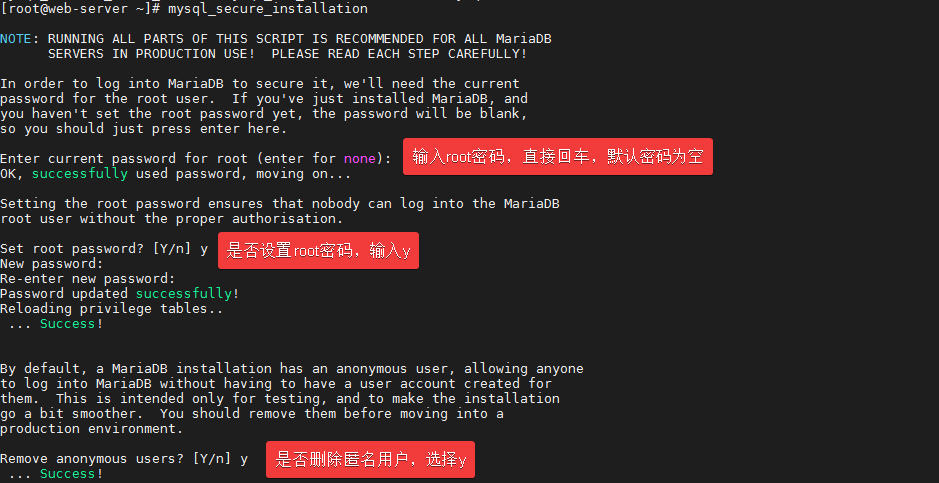
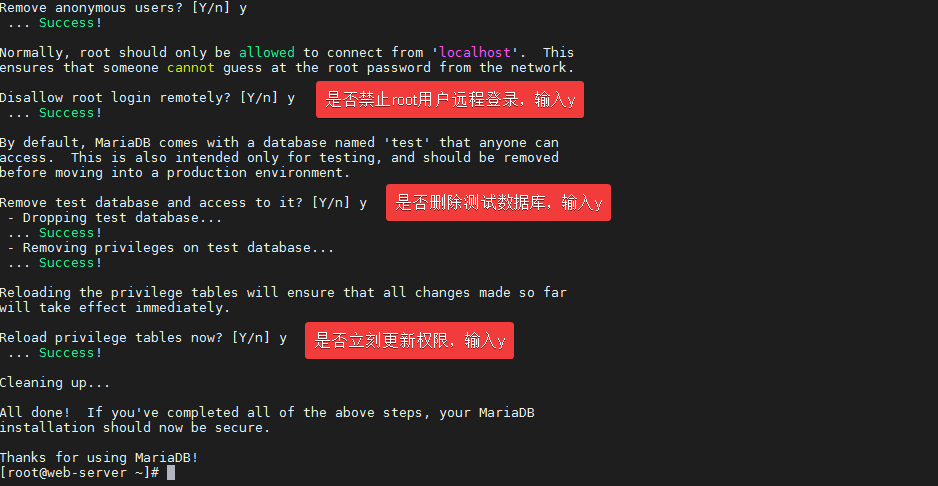
配置drupal网站的数据库:
# mysql -u root -p //登录mysql,会要求输入root密码
接着操作:
MariaDB [(none)]> create database drupal; //新建数据库drupal MariaDB [(none)]> GRANT ALL PRIVILEGES ON drupal.* TO db_user@localhost IDENTIFIED BY 'pass123'; //设置用户和权限,本地用户为db_user,密码为pass123 MariaDB [(none)]> FLUSH PRIVILEGES; //更新权限 MariaDB [(none)]> exit //退出mysql命令行
四、部署drupal网站
使用ssh工具把网站压缩包drupal-8.8.5.zip上传到服务器/var/www/中
# cd /var/www/ //切换到www目录中 # yum install -y unzip //安装unzip软件包 # unzip drupal-8.8.5.zip //把压缩文件解压到当前目录
修改nginx配置文件/etc/nginx/nginx.conf,以:
# For more information on configuration, see:
# * Official English Documentation: http://nginx.org/en/docs/
# * Official Russian Documentation: http://nginx.org/ru/docs/
user nginx;
worker_processes auto;
error_log /var/log/nginx/error.log;
pid /run/nginx.pid;
# Load dynamic modules. See /usr/share/doc/nginx/README.dynamic.
include /usr/share/nginx/modules/*.conf;
events {
worker_connections 1024;
}
http {
log_format main '$remote_addr - $remote_user [$time_local] "$request" '
'$status $body_bytes_sent "$http_referer" '
'"$http_user_agent" "$http_x_forwarded_for"';
access_log /var/log/nginx/access.log main;
sendfile on;
tcp_nopush on;
tcp_nodelay on;
keepalive_timeout 65;
types_hash_max_size 2048;
client_max_body_size 20m;
include /etc/nginx/mime.types;
default_type application/octet-stream;
# Load modular configuration files from the /etc/nginx/conf.d directory.
# See http://nginx.org/en/docs/ngx_core_module.html#include
# for more information.
include /etc/nginx/conf.d/*.conf;
server {
# server_name example.com;
listen 80;
root /var/www/drupal-8.8.5; ## <-- Your only path reference.
location = /favicon.ico {
log_not_found off;
access_log off;
}
location = /robots.txt {
allow all;
log_not_found off;
access_log off;
}
# Very rarely should these ever be accessed outside of your lan
location ~* \.(txt|log)$ {
allow 192.168.0.0/16;
deny all;
}
location ~ \..*/.*\.php$ {
return 403;
}
location ~ ^/sites/.*/private/ {
return 403;
}
# Block access to scripts in site files directory
location ~ ^/sites/[^/]+/files/.*\.php$ {
deny all;
}
# Allow "Well-Known URIs" as per RFC 5785
location ~* ^/.well-known/ {
allow all;
}
# Block access to "hidden" files and directories whose names begin with a
# period. This includes directories used by version control systems such
# as Subversion or Git to store control files.
location ~ (^|/)\. {
return 403;
}
location / {
# try_files $uri @rewrite; # For Drupal <= 6
try_files $uri /index.php?$query_string; # For Drupal >= 7
}
location @rewrite {
rewrite ^/(.*)$ /index.php?q=$1;
}
# Don't allow direct access to PHP files in the vendor directory.
location ~ /vendor/.*\.php$ {
deny all;
return 404;
}
# Protect files and directories from prying eyes.
location ~* \.(engine|inc|install|make|module|profile|po|sh|.*sql|theme|twig|tpl(\.php)?|xtmpl|yml)(~|\.sw[op]|\.bak|\.orig|\.save)?$|^(\.(?!well-known).*|Entries.*|Repository|Root|Tag|Template|composer\.(json|lock)|web\.config)$|^#.*#$|\.php(~|\.sw[op]|\.bak|\.orig|\.save)$ {
deny all;
return 404;
}
# In Drupal 8, we must also match new paths where the '.php' appears in
# the middle, such as update.php/selection. The rule we use is strict,
# and only allows this pattern with the update.php front controller.
# This allows legacy path aliases in the form of
# blog/index.php/legacy-path to continue to route to Drupal nodes. If
# you do not have any paths like that, then you might prefer to use a
# laxer rule, such as:
# location ~ \.php(/|$) {
# The laxer rule will continue to work if Drupal uses this new URL
# pattern with front controllers other than update.php in a future
# release.
location ~ '\.php$|^/update.php' {
fastcgi_split_path_info ^(.+?\.php)(|/.*)$;
# Ensure the php file exists. Mitigates CVE-2019-11043
try_files $fastcgi_script_name =404;
# Security note: If you're running a version of PHP older than the
# latest 5.3, you should have "cgi.fix_pathinfo = 0;" in php.ini.
# See http://serverfault.com/q/627903/94922 for details.
include fastcgi_params;
# Block httpoxy attacks. See https://httpoxy.org/.
fastcgi_param HTTP_PROXY "";
fastcgi_param SCRIPT_FILENAME $document_root$fastcgi_script_name;
fastcgi_param PATH_INFO $fastcgi_path_info;
fastcgi_param QUERY_STRING $query_string;
fastcgi_intercept_errors on;
# PHP 5 socket location.
#fastcgi_pass unix:/var/run/php5-fpm.sock;
# PHP 7 socket location.
fastcgi_pass unix:/var/run/php-fpm/php-fpm.sock;
}
# Fighting with Styles? This little gem is amazing.
# location ~ ^/sites/.*/files/imagecache/ { # For Drupal <= 6
location ~ ^/sites/.*/files/styles/ { # For Drupal >= 7
try_files $uri @rewrite;
}
# Handle private files through Drupal. Private file's path can come
# with a language prefix.
location ~ ^(/[a-z\-]+)?/system/files/ { # For Drupal >= 7
try_files $uri /index.php?$query_string;
}
location ~* \.(js|css|png|jpg|jpeg|gif|ico|svg)$ {
try_files $uri @rewrite;
expires max;
log_not_found off;
}
# Enforce clean URLs
# Removes index.php from urls like www.example.com/index.php/my-page --> www.example.com/my-page
# Could be done with 301 for permanent or other redirect codes.
if ($request_uri ~* "^(.*/)index\.php(.*)") {
return 307 $1$2;
}
}
}
重启nginx服务:
# systemctl restart nginx
网站部署过程中,会自动写入一些文件,需要先开启写入权限(部署完成后关闭写入权限):
# chmod o+w /var/www/drupal-8.8.5/sites/default/
# cp /var/www/drupal-8.8.5/sites/default/default.settings.php /var/www/drupal-8.8.5/sites/default/settings.php //复制settings.php文件
# chmod o+w /var/www/drupal-8.8.5/sites/default/settings.php //设置配置文件权限
浏览器访问服务器地址,自动开始网站的初始化部署


配置数据库连接信息,使用之前创建的数据库、用户和密码:
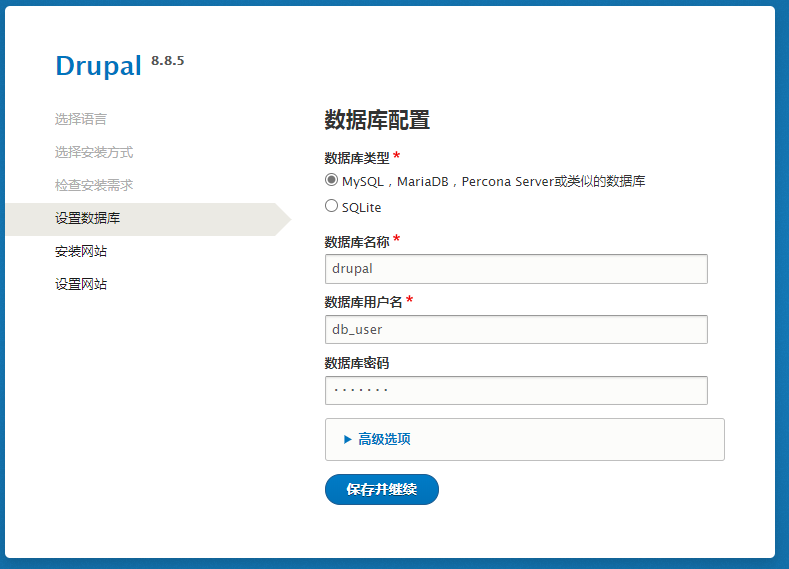

配置网站基本信息,包括创建管理员帐号
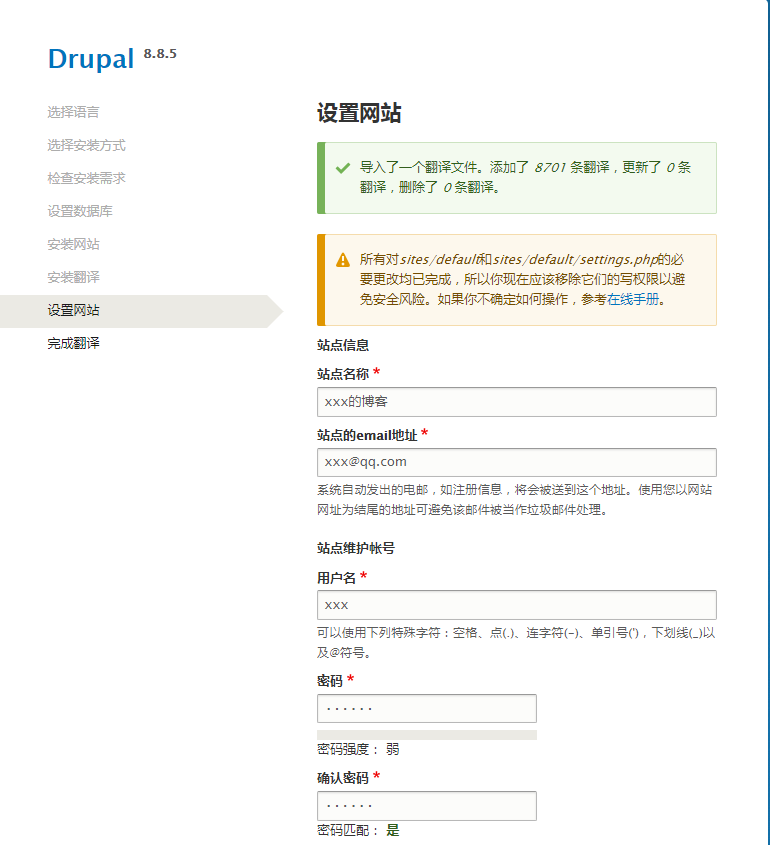
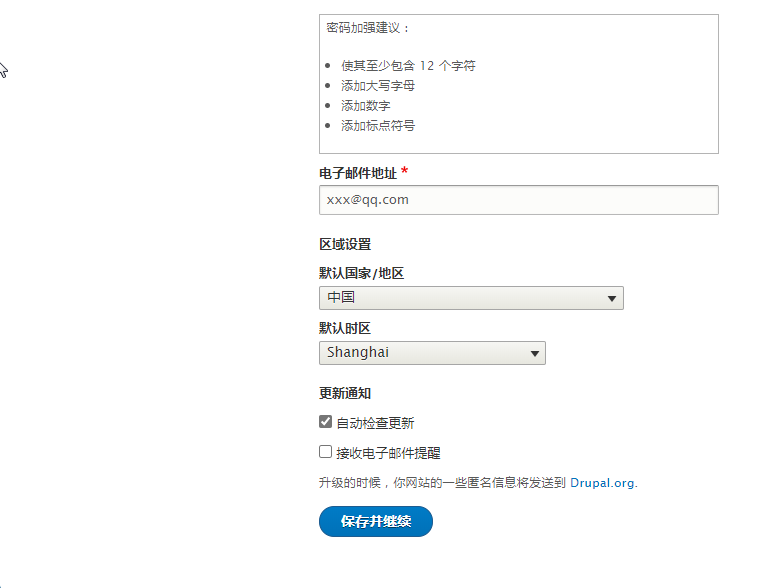
安装完毕后,自动访问网站:
安全考虑,移除之前设置的写入权限:
# chmod o-w /var/www/drupal-8.8.5/sites/default/settings.php # chmod o-w /var/www/drupal-8.8.5/sites/default



 浙公网安备 33010602011771号
浙公网安备 33010602011771号